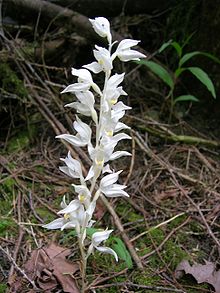Phantom orchid
| Phantom orchid | |
|---|---|
 |
|
| Scientific classification | |
| Kingdom: | Plantae |
| (unranked): | Angiosperms |
| (unranked): | Monocots |
| Order: | Asparagales |
| Family: | Orchidaceae |
| Subfamily: | Epidendroideae |
| Tribe: | Neottieae |
| Subtribe: | Limodorinae |
| Genus: | Cephalanthera |
| Species: | C. austiniae |
| Binomial name | |
|
Cephalanthera austiniae (A.Gray) Heller |
|
| Synonyms | |
|
|
Cephalanthera austiniae is a species of orchid known by the common names phantom orchid and snow orchid because the entire plant is white except for a few yellow markings on the flowers.
The orchid is native to the western United States (California, Oregon, Washington and Idaho), and to British Columbia, Canada. Cephalanthera austiniae is the only species of genus Cephalanthera native to the Western Hemisphere.
This is also the only Cephalanthera species entirely dependent on symbiotic mycorrhizae for its nutrition. This mycoheterotrophic orchid has no chlorophyll, so it makes no energy for itself.
Cephalanthera austiniae is a distinctive plant, rising from the dark, moist forest floor on waxy white stems and bearing orchid blossoms which are white or yellowish with yellow centers. Its leaves, if present, are rudimentary since such structures are not needed for collecting sunlight.
The plant is becoming more scarce as its habitat, dense, isolated forest, becomes more rare.
...
Wikipedia
